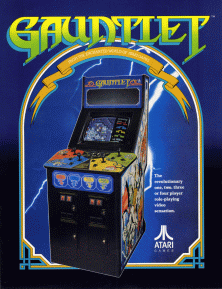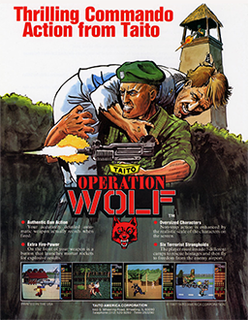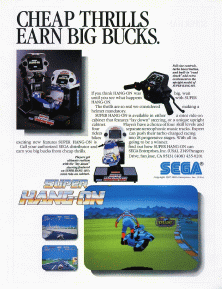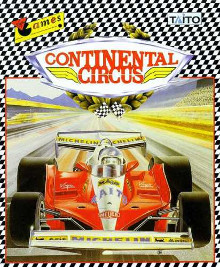Related Research Articles

Arkanoid is a 1986 block breaker arcade game developed and published by Taito. In North America, it was published by Romstar. Controlling a paddle-like craft known as the Vaus, the player is tasked with clearing a formation of colorful blocks by deflecting a ball towards it without letting the ball leave the bottom edge of the playfield. Some blocks contain power-ups that have various effects, such as increasing the length of the Vaus, creating several additional balls, or turning the Vaus into a laser cannon. Other blocks may be indestructible or require multiple hits to break.
Racing games are a video game genre in which the player participates in a racing competition. They may be based on anything from real-world racing leagues to fantastical settings. They are distributed along a spectrum between more realistic racing simulations and more fantastical arcade-style racing games. Kart racing games emerged in the 1990s as a popular sub-genre of the latter. Racing games may also fall under the category of sports video games.

Final Lap is a racing simulation video game developed by Namco and released in Japan in 1987. Atari Games published the game in the United States in 1988. It was the first game to run on Namco's then-new System 2 hardware and is a direct successor to Namco's Pole Position (1982) and Pole Position II (1983). A port for the Nintendo Famicom was developed by Arc System Works.

Out Run is an arcade driving video game released by Sega in September 1986. It is known for its pioneering hardware and graphics, nonlinear gameplay, a selectable soundtrack with music composed by Hiroshi Kawaguchi, and the hydraulic motion simulator deluxe arcade cabinet. The goal is to avoid traffic and reach one of five destinations.

After Burner is an arcade vehicular combat game developed and released by Sega in 1987. The player assumes control of an American F-14 Tomcat fighter jet, and must clear each of the game's eighteen unique stages by destroying incoming enemies, using both a machine gun and a limited supply of heat-seeking missiles. It uses a third-person perspective, previously utilized by Sega's earlier games Space Harrier (1985) and Out Run (1986), and runs on the Sega X Board arcade system, which is capable of surface and sprite rotation. It is the fourth Sega game to use a hydraulic "taikan" motion simulator arcade cabinet, one that is more elaborate than their earlier "taikan" simulator games. The cabinet simulates an aircraft cockpit, with flight stick controls, a chair with seatbelt, and hydraulic motion technology that moves, tilts, rolls and rotates the cockpit in sync with the on-screen action.

Gauntlet is a 1985 fantasy-themed hack-and-slash arcade game developed and released by Atari Games. It is noted as being one of the first multiplayer dungeon crawl arcade games. The core design of Gauntlet comes from 1983 Atari 8-bit dungeon crawl game Dandy, which resulted in a threat of legal action. It also bears striking similarities to the action-adventure maze game Time Bandit (1983).

Operation Wolf is a light gun shooter arcade game developed by Taito and released in 1987. It was ported to many home systems.

Operation Thunderbolt is a light gun shooter video game developed by Taito and released for arcades in 1988. As the sequel to Operation Wolf, changes include two-player gameplay with two positional gun controllers mounted on the arcade cabinet, and a new forward-scrolling pseudo-3D perspective combined with side-scrolling sections.

Hang-On is an arcade racing game released by Sega in 1985 and later ported to the Master System. In the game, the player controls a motorcycle against time and other computer-controlled bikes. It was one of the first arcade games to use 16-bit graphics and uses the Super Scaler arcade system board, created with design input from Yu Suzuki, as technology to simulate 3D effects. The deluxe cabinet version also introduced a motion-controlled arcade cabinet, where the player's body movement on a large motorbike-shaped cabinet corresponds with the player character's movements on screen.

Super Hang-On is a motorcycle racing arcade game released by Sega, and the sequel to the acclaimed Hang-On. It uses a fully simulated motorcycle arcade cabinet, like the original game. A version of this game, in the full simulated motorcycle cabinet used by the original Hang-On, was released in 1991 as Limited Edition Hang-On.
Combat flight simulators are vehicle simulation games, amateur flight simulation computer programs used to simulate military aircraft and their operations. These are distinct from dedicated flight simulators used for professional pilot and military flight training which consist of realistic physical recreations of the actual aircraft cockpit, often with a full-motion platform.

Pole Position II is the sequel to racing simulation game Pole Position, released by Namco for arcades in 1983. As with its predecessor, Namco licensed this game to Atari, Inc. for US manufacture and distribution. Atari Corporation released a port as the pack-in game for its Atari 7800 ProSystem console launch in 1986. Pole Position arcade machines can be converted to Pole Position II by swapping several chips.

Continental Circus is a racing simulation arcade game, created and manufactured by Taito in 1987. In 1989, ports for the Amiga, Amstrad CPC, Atari ST, Commodore 64, MSX and ZX Spectrum were published by Virgin Games.

Special Criminal Investigation, also known as S.C.I. for short or as Chase HQ II: Special Criminal Investigation in some home versions, is a 1989 vehicular combat racing game published by Taito for arcades. It is the sequel to the 1988 original Chase H.Q.

GP Rider is a 1990 motorcycle arcade racing game developed and manufactured by Sega, released in Japan, North America and Europe. It was released as two-player arcade cabinets, in the form of a ride-on motion simulator cabinet and a standard upright cabinet. It was ported to the Sega Master System and Game Gear in 1993.

Steel Talons is a 3D combat flight simulator arcade game released by Atari Games in 1991. The player takes on the role of a pilot for an "AT1196 Steel Talons combat helicopter". Steel Talons was ported to the Sega Genesis, Atari Lynx, Atari ST, and the Super Nintendo Entertainment System. A Jaguar port was announced, but never released.

Air Inferno is a 1990 flight simulation arcade video game developed and released by Taito, in Japan, Europe and North America. A spin-off from Taito's Landing series, Air Inferno is an aerial firefighting simulation that involves piloting a helicopter on various rescue missions, shooting a fire extinguisher to extinguish flames while rescuing civilians.

Thunder Blade is a third-person combat flight simulator video game released by Sega for arcades in 1987. Players control a helicopter to destroy enemy vehicles. The game was released as a standard stand-up arcade cabinet with force feedback, as the joystick vibrates. A helicopter shaped sit-down model was released, replacing the force feedback with a cockpit seat that moves in tandem with the joystick. It is a motion simulator cabinet, like the previous Sega Super Scaler games Space Harrier (1985) and After Burner (1987). The game's plot and setting was inspired by the film Blue Thunder (1983).

Winning Run is a first-person arcade racing simulation game developed and published by Namco in late December 1988 in Japan, before releasing internationally the following year. The player pilots a Formula One racer, with the objective being to complete each race in first place, all while avoiding opponents and other obstacles, such as flood-hit tunnels, pits and steep chambers. It was the very first game to run on the Namco System 21 arcade hardware, capable of 3D shaded polygons.
References
- ↑ Arsenault, Dominic (2017). Super Power, Spoony Bards, and Silverware: The Super Nintendo Entertainment System. MIT Press. p. 129. ISBN 978-0-262-03656-6.
- ↑ "Looking At Taito's history As They Turn 60". Arcade Heroes. 2013-08-27. Retrieved 19 May 2021.
- ↑ "Midnight Landing". Media Arts Database (in Japanese). Agency for Cultural Affairs . Retrieved 8 July 2021.
- ↑ Akagi, Masumi (October 13, 2006). アーケードTVゲームリスト国内•海外編(1971–2005) [Arcade TV Game List: Domestic • Overseas Edition (1971–2005)] (in Japanese). Japan: Amusement News Agency. p. 136-7. ISBN 978-4990251215.
- ↑ "Arcade Action". Computer and Video Games . No. 70 (August 1987). United Kingdom: EMAP. 15 July 1987. p. 110-2.
- ↑ "Top landing (Registration Number PA0000494009)". United States Copyright Office . Retrieved 8 July 2021.
- ↑ Kelly, Nick (19 December 1988). "Arcades". Commodore User . No. 64 (January 1989). United Kingdom: EMAP. pp. 100–3.
- ↑ "Game Machine's Best Hit Games 25: '87" (PDF). Game Machine (in Japanese). No. 324. Amusement Press, Inc. 15 January 1988. p. 20.
- ↑ "Game Machine's Best Hit Games 25: '88 / "Game of the Year '88" By Game Machine" (PDF). Game Machine (in Japanese). No. 348. Amusement Press, Inc. 15 January 1989. pp. 10–1, 26.
- ↑ "Videos of The Year; "Tetris", "Chase H.Q."" (PDF). Game Machine (in Japanese). No. 372. Amusement Press, Inc. 15 January 1990. p. 26.
- ↑ Openshaw, Mary (March 1990). "Paris Says Oui! Pins, video and — surprise! — poll all shine at best Paris show ever". RePlay. Vol. 15, no. 6. pp. 134–5.
- ↑ "RePlay: The Players' Choice". RePlay. Vol. 15, no. 11. August 1990. p. 4.